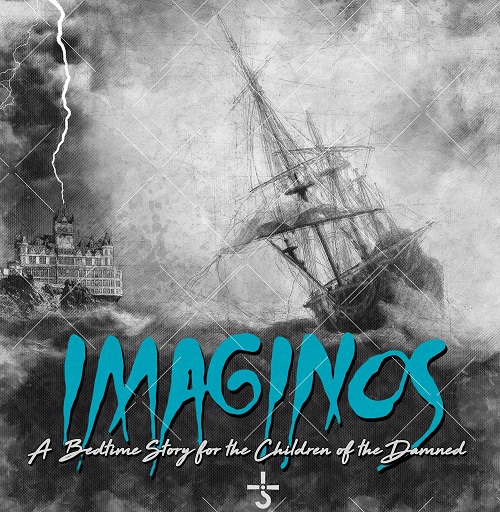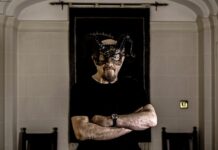Imaginos was conceived by Sandy Pearlman, an “under-appreciated” rock impresario to some degree who managed Blue Öyster Cult, wrote loads of their lyrics, produced their albums, and went on to write and produce records with the likes of the Clash and Dream Syndicate before ascending into the world of academia.
According to Albert Bouchard, the original drummer for Blue Öyster Cult, Pearlman first shared the Imaginos story after one of the band’s practices some time in 1967. “We were just hanging out with Sandy,” he tells me. “And he started telling us this story about this imaginary person, this person that changes shapes. It could be a space alien, it could be anything.”
“Anything” is putting it lightly. Depending on who you ask, Imaginos is as much about the future as it is about the past. It’s science fiction, it’s history, it’s horror, it’s rock and roll — and a total enigma. It took on the shape of a rock opera, with Pearlman and Bouchard leading the way. Finally, in 1988, it ended up as a Blue Öyster Cult album with lots of special guests. The timing and little help from the record label curtailed the recognition it deserved, which resulted in less than satisfactory sales.
That did little to detract from its mystic. Author Stephen King recorded a spoken narration for a video behind Imaginos, stating it is “a bedtime story for the children of the damned. From a dream world, paralleling our earth in time and space, the invisible ones have sent an agent who will dream the dream of history. With limitless power, he becomes the greatest actor of the 19th century. Taking on many ingenious disguises, he places himself at pivotal junctures in history, continually altering its course and testing our ability to respond to the challenge of evil. His name is Imaginos.”

There’s a YouTube video that spends nearly two hours explaining the auspicious origins and various meanings of Imaginos. The name “Blue Öyster Cult” is part of the story. Some of the songs from Imaginos, described as a “rock horror mythos,” like “Subhuman” and “Astronomy,” are on early BÖC albums. Albert Bouchard also made a version of his own that was never released.
The Blue Öyster Cult release of Imaginos was recorded and released years after Bouchard and the band parted ways, though it reconnected the drummer with the members of Blue Öyster Cult on unspoken terms. A lot of the recordings he had done for his version were recut with new vocals and instrumentation. BÖC’s Eric Bloom and Buck Dharma sang most of the most songs, though some of Bouchard’s vocals were kept. Other singers like Jon Rogers and Joe Cerisano were also brought in. A couple of the songs that helped tell the story were left off as well.
“Instead of it being a two-record set, it was only going to be a one-record set.” Bouchard explains. “I was disappointed that it wasn’t my record. It wasn’t my springboard. I also thought that if BÖC was going to put it out, that they were going to want me to be back in the band. I had been told as much by the management, but when the thing came out and I heard that they were doing a tour of Greece, they told me, ‘No, you’re not going. We got another drummer.’ I’m like, ‘Well, I can sing,’ and they’re like, ‘No, no, no…Eric and I are going to sing.’ So, that was that.”

Over 30 years later, Bouchard finally decided to record a completely new version called Re Imaginos. Following through on a promise he made to Pearlman shortly before his death in 2016 — that he was going to release Imaginos “the way that you wanted it to be put out” — Re Imaginos allowed him to add the songs back into the rotation, place them in their original running order, and tell the story as it was intended, with a few concessions made along the way.
“The whole time, I had a chronology in my head,” he says. “So when I did this version, Re Imaginos, I realized that there were several songs that just could go anywhere in the chronology and they would fit,” Bouchard says. “There were others that really needed to be in a certain order. For instance, ‘Siege And Investiture Of Baron Von Frankenstein’s Castle At Weisseria’ had to be next to ‘Girl That Love Made Blind’ because those lyrics were one song at one time. I said, while we were working on it, ‘Sandy, you have so many lyrics, let’s make it two different songs.’ And he said, ‘Oh, good idea.’ So we made them two songs, but they are part of the same story. So whether it’s ‘The Girl That Love Made Blind’ that’s first or ‘Siege And Investiture Of Baron Von Frankenstein’s Castle At Weisseria’ is first, it didn’t matter, but they had to be together.”
“The Girl That Love Made Blind” is one of two songs that Bouchard brought back to the story. The other is “Gil Blanco County,” co-written by Sandy Pearlman and original BÖC keyboardist Allen Lanier, who passed away in 2013. A third song called “Black Telescope” was intended for an Imaginos sequel, so to speak.
“When Sandy got me a record deal with Columbia, it was for supposed to be for three double album vinyl sets. We were going to put ‘Black Telescope’ on the second record, the second volume of Imaginos. It was going to be called Bombs Over Germany. With ‘Black Telescope,’ it was going to have ‘ME 262,’ ‘Flaming Telepaths,’ and ‘OD’d On Life Itself.’ After I finished putting together this record, I thought ‘Black Telescope’ would fit better because it is more of a seafaring song. A lot of it takes place with the sailor and the sea and the fish and the telescope — it’s all tools of the maritime trade. I already had a pretty nifty arrangement of it. It’s nothing like Blue Öyster Cult.”
Peruse the packaging for Re Imaginos and you’ll realize Bouchard got lots of help to make this record. The players who played on Bouchard’s original recording of Imaginos receive a nod, while a “special thanks” goes to Joe Cerisano, Eric Bloom and Buck Dharma for their vocals on the BÖC version. Bouchard also cites his “partner in crime” David Hirschberg, who plays bass and guitar on the record, and the other contributing musicians — guitarists RJ Ronquillo, Ross “The Boss” Friedman, Doctor Jack Rigg and Vaughn Burton, plus Greg Holy on violin, Mookie Thomas on keyboards, Prince Omega on drums, guitars and keyboards, and Justin “Compton Timberwolf” Robinson on demo drums. Bouchard’s brother, Joe (another original member of BÖC), plays piano and trumpet and his son, Ace, plays keyboards.
***
Despite the difficulties surrounding Imaginos and the years that followed, Bouchard managed to stay in touch with both Sandy Pearlman and Blue Öyster Cult. He went to see Pearlman in 2016 just before he passed away.
“It was basically two days of me talking almost constantly for eight hours and telling stories, talking about friends, singing songs,” Bouchard remembers. “I sang one of the songs that’s supposed to be on volume two that nobody’s ever heard except for Sandy. I sang that for him.”
And that’s when he told Pearlman of his plans to record the piece the way it was originally envisioned.
Bouchard is also happy to report that he’s on great terms with Blue Öyster Cult. Since the original lineup reunited for a show in New York City in 2012, the drummer has regularly sat in with the present lineup. “In 2016, it was the 40th anniversary of Agents Of Fortune. They took me on tour with them and I played a half a dozen gigs. I went to Ireland with them and UK and played three shows in New York.”
On a more recent front, Bouchard makes an appearance on BÖC’s 2020 studio release, The Symbol Remains. “I’m on the first song and I sing the harmony with Eric,” he laughs. “And I’m in the video.”
Bouchard’s history with BOC, of course, is something neither he nor his fans are likely to forget about anytime soon. As a reminder, he initially offered a signed cowbell in a bundle that included the Re Imaginos CD, t-shirt and guitar picks. It instantly sold out. Since the infamous skit on Saturday Night Live featuring Christopher Walken and Will Ferrell that poked fun at the band — the cowbell and its role in “(Don’t Fear) The Reaper” have grown to mythic proportions. Between that and his “Most Cowbell’ vlog (now in its fifth season), it was obligatory that Bouchard, the drummer on the song, should share his side of the story of how the cowbell came to be used on “(Don’t Fear) The Reaper.”
“The skit is way closer to the truth than you would imagine,” he laughs. “We knew that ‘Reaper’ was going to be a hit.”
As Bouchard tells it, the song went through various arrangements, with co-producer David Lucas going so far as to bring in Randy Brecker to add horns.
“And we didn’t like it. We said, ‘Erase that, that’s doesn’t fit on the song.’ We wanted to go to a different place, but you know, ‘We’ve changed key. We’ve changed the mode. The rhythm is all different. Everything is different. We don’t need a trumpet to take it even further.’ There was already a guitar lead on there and it was a very good guitar lead. So we erased Randy Brecker and there was an extra track. So I said, ‘You know what would be a cool thing in that middle section, instead of a trumpet — how about a triangle?’”
Lucas was fine with adding the triangle, but then he threw out another idea: “I’d like you to try putting a cowbell in the song.” Bouchard told the producer he didn’t have a cowbell, which wasn’t a problem because Lucas did. After further back and forth about the pattern, Bouchard told the producer: “David, it doesn’t sound good. I think it’s too much.”
It’s no surprise Buck Dharma, the man who wrote and sang the song, didn’t initially like the cowbell. Lucas pushed on, undeterred. He had Bouchard wrap the cowbell in gaffer tape to mute the ring. Though it was improvement, the drummer grabbed a timpani mallet from his stick bag to reduce the ring even further. At that point, it sounded less like a cowbell and more like a woodblock.
“Dharma’s like ‘Yeah. That’s good,’ Bouchard recalls. “So when they were mixing it, I’m telling them to turn that cowbell down a little bit more. And David’s like, ‘If I turn it down anymore, you’re not going to hear it at all.’ If you listen to the original version, you can barely hear the cowbell. So when I saw the Will Ferrell skit, I said, ‘How did he even hear it in the first place? I mean, that’s just bizarre.’ Which makes it so much funnier because a lot of people didn’t even know there was a cowbell on the track.”
During the pandemic lockdown, Bouchard has busied himself with promoting Re Imaginos, releasing several videos on YouTube channel. After his time with Blue Öyster Cult, he became a school teacher. It was near the end of his teaching days that he started his “Most Cowbell’ vlog. He’s also produced videos behind “Black Telescope” and “Blue Öyster Cult.” Once things get back to normal, he’s hoping to play the album live.
“I don’t even have a band,” he laughs. “I know that it’ll be me and David Hirschberg. I would really rather play guitar than drums, just because it’s easier to be a front person and do that on a guitar. I’ve learned how to play and sing all the songs together. I didn’t really do that even when I was recording, but I can do it well enough to pull off a live show. I would need to get a really good drummer.”
Living in the new abnormal, Bouchard is doing everything he can to keep momentum going. “We’re working on a bonus song for the vinyl package because DEKO has agreed to put out the double-record set of Imaginos, just as it was supposed to be in the first place.” he says. “I’m so happy with these guys. The reaction has been pretty astounding to me. I knew that there would be some fans that would really like it. I’ve been getting emails from them for years — ‘When you going to put out the demos?’ ‘When are you going to be put out your version of Imaginos?’ ‘Are you going to rerecord it?’ ‘Are you just going to remix it?’ There were a lot of questions.”
Through trial and error, pain and loss, Bouchard’s Re Imaginos has provided the answer so many have been waiting for.




















